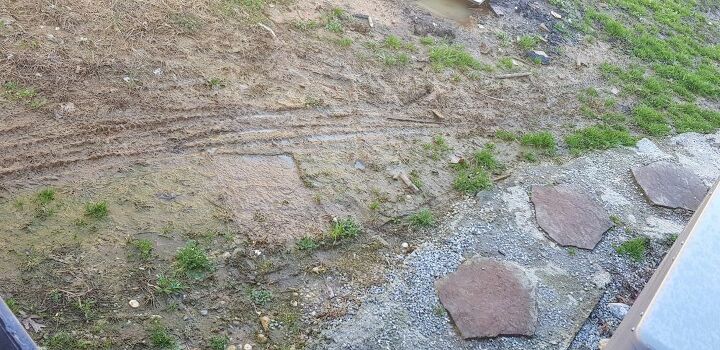How do I fill large holes in the yard?
We are moving into a home where the previous owner had dogs that loved to dig. There are deep holes all through the yard. Can anyone help with how to fill holes in a yard so they won’t sink again when it rains?
Best tool for filling garden holes!
Related Discussions
GNATS - How to get rid of them?
Somehow my house and garden got tiny gnats that killed my fuchsia plant and fly everywhere. I have tried ALL the Web recommendations - soap and oil dishes, sand in th... See more
Marigolds growing! Should I pinch the buds?
My marigold plants are growing. I heard that pinching the buds until Autumn will allow them to grow without killing the plant. Is this true?
Growing garlic
Growing our first garlic, should we wait until the leaves are drying out before we pick it? Husband picked first one today along with our first potatoes.
How to keep mice out of your garden?
Hi everyone, I have mice in my garden destroying my vegetables and I have also noticed them in the barn and shed. Please can someone tell me how to prevent them from ... See more
What's the best flower/plant to grow in Texas?
I know that opinions vary, but what's your opinion?!I have great luck w Rosemary plants. Green all year long.
What can I use to fill in a large wet area in my yard?
I have a walk way of my yard that Is a never ending mud hole. What else can I use to make this an accessible walkway. I've tried EVERYTHING
I have little perfectly round holes in my yard... do you know why?
They are just at random and I see no worms or bugs . What is your opinion?




Fill them up with dirt or soil. They will continue to sink until such time as soil becomes as compacted as the surrounding area.
Fill the hole with fill soil to within 1 inch of ground level, using a garden spade or scoop shovel. Mix together equal parts fill dirt and compost with a garden fork. The amount of fill dirt and compost you need depends on the size of the hole.
When I've filled holes in the yard, I've always put in some topsoil, then tamped down (there's a tool for this), then added more topsoil, repeat the tamping, etc. Invariably, rain and time settles the soil, and I've always needed to add more. So if you have a lot of holes, you could get topsoil delivered by truck and have it dumped where you can take wheelbarrows of it to the yard, and keep some on hand for refilling the holes as they sink.
The only other thing I can think of is to have the whole yard dug and leveled, adding topsoil as necessary.
Beverly,
The gravel will not prevent sinking. As suggested, you need to tamp the soil to match the surrounding areas. If a square tamping tool is to big or heavy for you to manage, take a length of scrap 2x4 and make it a comfortable length so you are not bending over to far. Use it to tamp the soil. You can also take to pieces the same length, screw them together and use them both at the same time, which will give you more tamping surface.
Hi Beverly. I'm Cindy. I would not put rocks in the holes. Sooner or later some will come to the surface. And you don't want your lawn mower to shoot out any rocks. It could be very dangerous and it might take chunks out of the lawn mower's blade. Fill the holes with fill dirt almost to the top. Then mix one part each of top soil, manure, and sand. Then mix in some grass seed and top the holes off with this mix. Keep them watered and you will see new grass in approx 6 weeks. Good luck Beverly.
Hi Beverly, we had a similar problem when we moved into our home years ago. Your best bet is to mix up some topsoil and sand and/or compost. Fill the holes and trample it down hard to compact as much as possible. Fill again and repeat. You may find a small indent after the first rains so save some of the soil mixture to repeat again.
We had an issue after we had our cesspool replaced. They left a deep hole over the old one. We just kept filling it with dirt and tamping it down. It would get wet and settle and we would add more dirt. It took about a full year of weather changes to fully settle.
Sounds like you just need to get more soil and fill the holes. You may have to do this more than once since the first fill will most likely compact down and you'll need to add some more later in the season. After that, then you can add grass seed and try to get your lawn back to normal again.
Find soil and fill the holes with this. Wait awhile as the soil will settle, then add more. Then you could sprinkle grass seed on top and water.
Have a landscaping supply company drop off a load of soil and refill the holes. It will settle so you might have to top off again after a year or so.
If you can find fill dirt or good topsoil so you can fill these holes, tap them down and keep up the process after each rain. Plant grass seeds in the late fall or early spring so they can establish a good root system.
Depending on how deep the holes are, mitigating how much the fill material sinks over time can be done by tamping (soil should be very moist for best compaction), but tamping only reaches 2"-3" depth at a time, so you may need repeat "layers". Frequent heavy watering also speeds up compaction. Adding sand to your fill mixture will help in the long run, because soil breaks down (settles) over time, whereas sand remains stable. That's why sand is used to level golf turf. Yet, while soil compaction mitigates the problem of settling (sinking) over time, it creates a problem for new grass (which requires looser soil to grow well). I've had to make the same choice myself and would rather have healthy grass and adjust spots that settle later, versus grass that struggles to thrive in areas filled with highly compacted soil.
IF YOU HAVE BORDERS OR FLOWER BEDS, USE SOME OF THAT SOIL AND THEN REPLACE FROM DONNER SITE WITH cOMPOST!